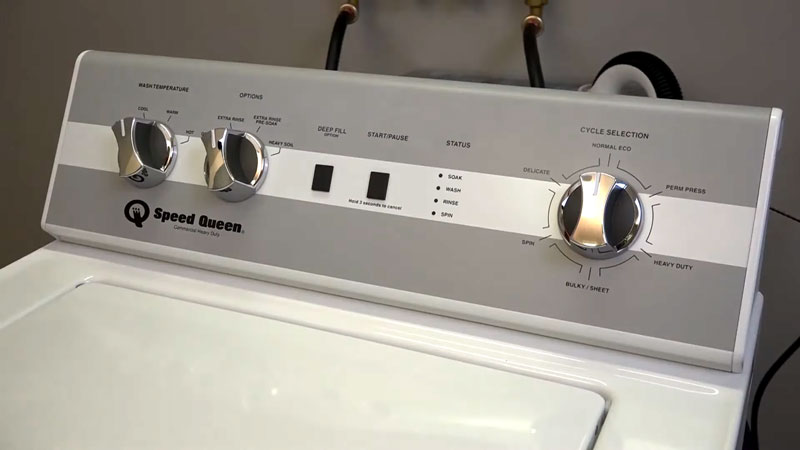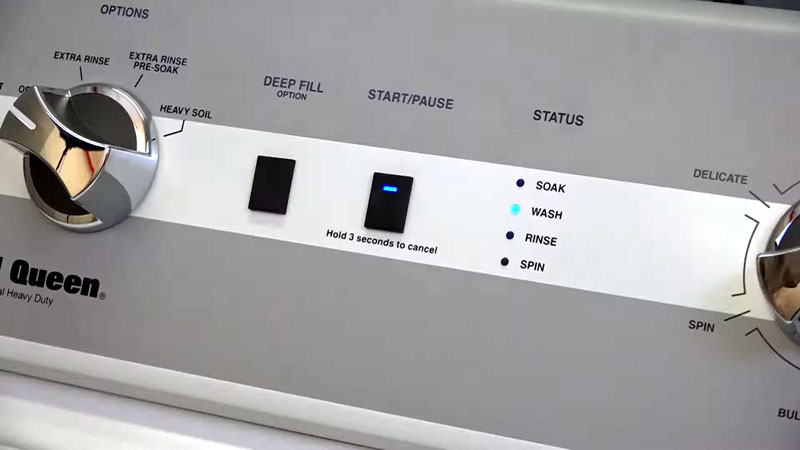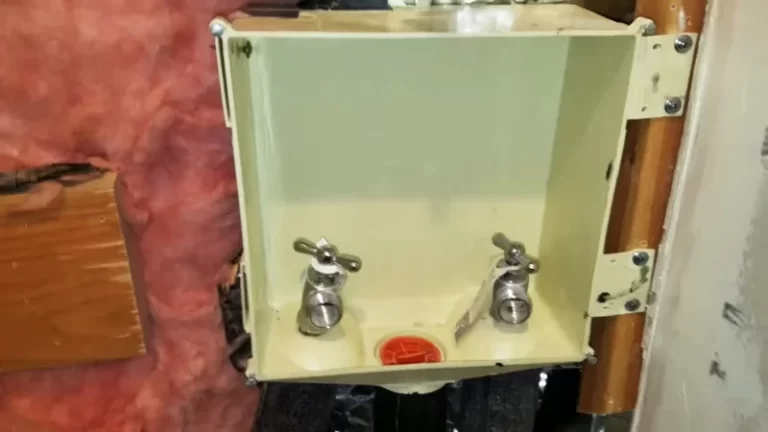Why the Speed Queen Washer is Tripping GFCI

A GFCI, or Ground Fault Circuit Interrupter, outlet is a type of electrical outlet that is designed to protect against electrical shock. It does this by detecting any ground faults, where the power supply line is shorted to the ground, and then interrupting the circuit to prevent injury.
GFCI outlets are commonly found in areas where water is present, such as kitchens and bathrooms, as they provide an extra layer of protection against the risk of electrical shock. It is important to have GFCI outlets installed in your home to ensure the safety of you and your family.
Symptoms of a Faulty Washer Tripping a GFCI Outlet
Generally, speed queen washers trip GFCI when the washer only trips the GFCI outlet, washer is okay plugged into a non-GFCI outlet, makes strange noises, has an improper drain, and doesn’t spin. For all the cases you should check the GFCI on the board if it has broken.
I. Washer Only Trips GFCI Outlet
One symptom of a faulty washer tripping a GFCI outlet is if the washer only trips the GFCI outlet and not other appliances. This could indicate that there is an issue specifically with the washer that is causing it to trip the GFCI outlet.
II. Washer Works Fine When Plugged into a Non-GFCI Outlet
Another symptom of a faulty washer tripping a GFCI outlet is if the washer works fine when plugged into a non-GFCI outlet, but trips the GFCI outlet when plugged into it. This could indicate that the issue is with the GFCI outlet itself, rather than the washer.
III. Washer Makes Strange Noises
A faulty washer may also exhibit strange noises, such as grinding or squealing sounds, which could be a sign of a problem with the motor or other internal components. These noises may be more pronounced when the washer is in use, and could potentially cause the GFCI outlet to trip.
IV. Washer Does Not Drain Properly
If the washer is not draining properly, it could cause the GFCI outlet to trip. This could be due to a clogged drain hose or a problem with the pump. Sometimes, the sink might gurgle.
V. Washer Does Not Agitate or Spin
If the washer is not agitating or spinning properly, it could also cause the GFCI outlet to trip. This could be due to a problem with the drive belt or motor and may require the assistance of an appliance repair technician to diagnose and fix.

Causes of a Washer Tripping a Gfci Outlet
Ground faults, faulty motor, wiring, pump, circuit board, clogged drain hose, and drive belt are the common causes why a washer Trips GFCI. It provides protection against electrical shock, fire, or other electrical malfunctions.
This is very important in a laundry room where many electrical appliances and cords are connected, and many parts of the house oftentimes are not grounded.
I. Ground Fault Within the Washer
One cause of a washer tripping a GFCI outlet is a ground fault within the washer itself. This occurs when the electrical current that comes in through the hot wire is shorted to the ground, either through the washer’s chassis or through another path such as a water line or the floor.
A ground fault can be dangerous and potentially cause an electrical shock, so it is important to address this issue as soon as it is noticed.
II. Faulty Motor
A faulty motor in the washer could also cause it to trip a GFCI outlet. The motor is responsible for driving the agitator and the spin cycle, and if it is not functioning properly it could potentially cause a ground fault.
III. Faulty Wiring
Another cause of a washer tripping a GFCI outlet could be faulty wiring within the washer. Wiring that is damaged or has worn-through insulation could potentially cause a ground fault and trip the GFCI outlet.
IV. Circuit Board Failure
A circuit board failure within the washer could also cause it to trip a GFCI outlet. The circuit board controls the various functions of the washer, and if it is not functioning properly it could potentially cause a ground fault.
V. Clogged Drain Hose
A clogged drain hose could cause the washer to trip a GFCI outlet if water is not able to drain properly. This could potentially cause a ground fault if the water comes into contact with electrical components.
VI. Faulty Pump
A faulty pump in the washer could also cause it to trip a GFCI outlet. The pump is responsible for moving water in and out of the washer, and if it is not functioning properly it could potentially cause a ground fault.
VII. Drive Belt or Motor Issues
Problems with the drive belt or motor in the washer could also cause it to trip a GFCI outlet. If the drive belt is not properly aligned or the motor is not functioning properly, it could potentially cause a ground fault.
How to Diagnose a Washer Tripping a GFCI Outlet?
To diagnose the cause of a ground fault that is causing a washer to trip a GFCI outlet, you can perform an electrical leak test. Here is a step-by-step guide on how to do this:

- Gather the necessary tools:
- Non-contact voltage tester
- Multimeter
- Unplug the washer from the outlet and make sure it is turned off.
- Test the outlet with the non-contact voltage tester to ensure that there is no power present.
- Set the multimeter to the “resistance” setting.
- Touch one probe of the multimeter to the ground terminal of the outlet and the other probe to the hot terminal.
- If the reading is anything other than infinite, it indicates that there is a ground fault present.
- Repeat this process for the neutral terminal.
- If the test indicates a ground fault, it is likely that there is a problem with the washer itself, such as a faulty motor, wiring, or circuit board. It may be necessary to have an appliance repair technician look at the washer to diagnose and fix the issue.
- If the test does not indicate a ground fault, it is possible that the issue is with the GFCI outlet itself and it may need to be replaced.
It is important to note that it is always best to have a qualified appliance repair technician perform any repairs on a washer to ensure that it is done safely and properly.
Repair or Replace Faulty Components as Necessary
If an electrical leak test or other diagnostic methods have identified faulty components within a washer that are causing it to trip a GFCI outlet, it will be necessary to repair or replace these components in order to fix the issue. Here is a general step-by-step guide on how to do this:
- Gather the necessary tools:
- Screwdriver
- Wrench (if necessary)
- Replacement parts (as needed)
- Unplug the washer from the outlet and make sure it is turned off.
- Consult the owner’s manual or a repair manual for the specific make and model of the washer to determine the location and method for accessing the faulty component.
- Use the screwdriver and wrench (if necessary) to remove any covers or panels that will allow you to access the faulty component.
- Carefully remove the faulty component and set it aside.
- Install the replacement component in its place, making sure to secure it properly.
- Replace any covers or panels that were removed and plug the washer back in.
- Test the washer to ensure that it is functioning properly and no longer trips the GFCI outlet.
It is important to follow the specific instructions for the make and model of the washer when performing repairs and to use caution when handling electrical components. If you are not confident in your ability to perform the repairs, it is best to have a qualified appliance repair technician do it for you to ensure the safety of you and your home.
Why Does My Speed Queen Washer Trip the Breaker?
- Overloaded circuit: If the circuit that the washer is plugged into is overloaded with too many appliances or devices, it could cause the breaker to trip.
- Faulty wiring: If the wiring within the washer is damaged or has worn-through insulation, it could cause a short circuit and trip the breaker.
- Faulty motor: A faulty motor in the washer could also cause the breaker to trip. The motor is responsible for driving the agitator and the spin cycle, and if it is not functioning properly it could potentially cause a short circuit.
- Circuit board failure: A circuit board failure within the washer could also cause the breaker to trip. The circuit board controls the various functions of the washer, and if it is not functioning properly it could potentially cause a short circuit.
- Clogged drain hose: If the drain hose is clogged and water is not able to drain properly, it could cause the breaker to trip. This could potentially cause a short circuit if the water comes into contact with electrical components.
- Drive belt or motor issues: Problems with the drive belt or motor in the washer could also cause the breaker to trip. If the drive belt is not properly aligned or the motor is not functioning properly, it could potentially cause a short circuit.
Should a Washer Be Plugged Into a GFCI Outlet?
According to the National Electrical Code (NEC), GFCI protection is required for outlets located in laundry areas, but not specifically for clothes washing machines. However, it is generally recommended to use GFCI outlets for appliances like washing machines, especially if they are located in areas where water is present.
GFCI outlets provide an extra layer of protection against the risk of electrical shock and can help to prevent accidents and injuries. If you are unsure about whether or not to use a GFCI outlet for your washing machine, it is best to consult with a licensed electrician or refer to the NEC for guidance.
Also, the GFCI should have a ground wire connection.
Final Words
If a washer is tripping a GFCI outlet, it could be due to a ground fault within the washer or an issue with the GFCI outlet itself. It is important to address this issue as soon as possible to prevent the risk of electrical shock and potential injury.
To diagnose the cause of the issue, an electrical leak test can be performed to determine whether the problem is with the washer or the outlet. If the issue is with the washer, faulty components such as the motor, wiring, or circuit board may need to be repaired or replaced.
If the issue is with the GFCI outlet, it may need to be replaced. It is always best to have a qualified appliance repair technician perform any repairs on a washer to ensure that it is done safely and properly.



![Why is the Maytag Washer Drum Loose? [Shaking Violently?]](https://fixitinthehome.com/wp-content/uploads/2023/01/Maytag-Washer-Drum-Loose-768x432.jpg)

